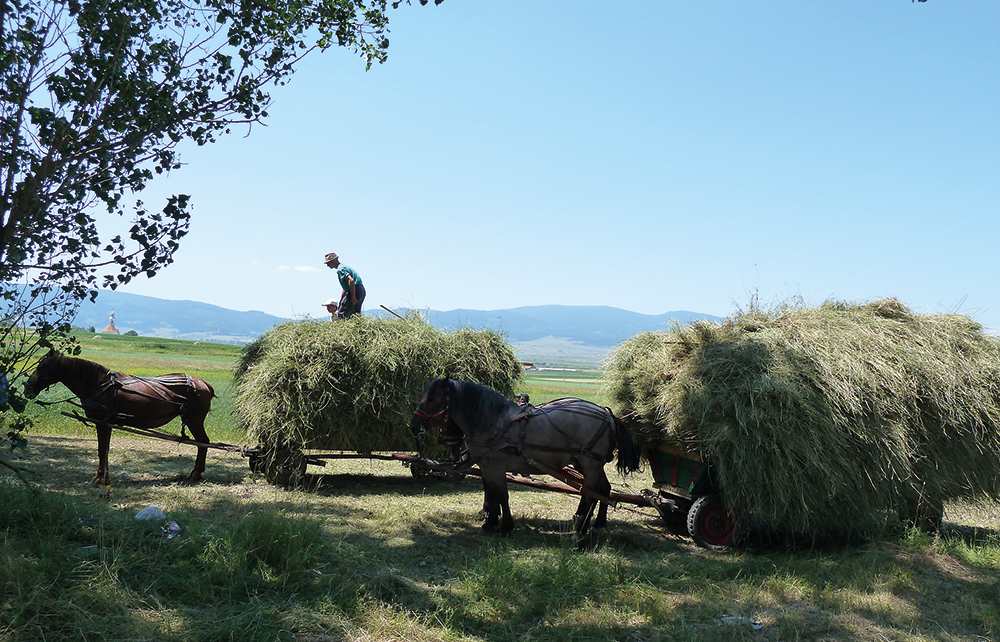Britain is one of the most nature-depleted places on Earth. The consequences for human wellbeing and resilience, as well as for non-human life, are grave. Conservationists and others say it doesn’t have to be this way. But when it comes to recovery, what should we aim for? How much can we know about what was once present? How much is it practicable or sensible to restore? What does recovery, let alone ‘rewilding’, really mean in a rapidly heating world? Sophie Yeo does not have the answers to all of these questions. Nobody does. What she does offer in Nature’s Ghosts are insights that could help shape a better informed and more constructive debate.
Corncrakes, rare to vanishing in Britain, flourish in a patchwork
quilt of fields in Transylvania
One of the first stops in Yeo’s explorations around Britain, and places in Europe that may offer lessons for Britain, is the Carrifran Wildwood in southern Scotland. Here, half a million or more trees of diverse indigenous species have been planted since the late 1990s in a glen formerly given over to grazing by sheep. In addition to the regrowth of the woodland itself, this has resulted in a spectacular increase in animal and bird life, including willow warblers, chaffinches and other woodland and scrubland birds, as well as mammals. But one of the most remarkable changes has been in floral diversity, with the recovery and spread of plants such as sea campion, which is usually associated with coastal landscapes.
As a rewilding project created through deliberate replanting, Carrifran may seem to present a paradox. There’s nothing wrong with this, say Yeo and her interlocutors. The idea of a ‘great wood of Caledon’ – a vast pine forest covering most of Scotland – is partly myth: the forest was never as extensive or as long-lasting as is often supposed. But humans can choose what they love and wish to encourage. Christopher Smout, Scotland’s Historiographer Royal, tells Yeo:
We should be planting new pine woods or extending existing ones not out of nostalgia for some dubious myth, but because we are lovers of Scotland and Scots pine, modern improvers who treasure the… ecosystem and relish the sight and smell of the woods today.
For Yeo, Carrifran offers glimpses of past wonders and future possibilities:
I see it not so much as a faithful replica of a vanished ecosystem but as an attempt to translate an ancient text. There may be gaps in the poetry, but that does not detract from the beauty of the endeavour.
Meadows of the Transylvanian and Carpathian basins are another stop on Yeo’s journey. Situated at the western edge of the vast Eurasian steppe, these lands appear to have been largely unforested since at least the start of the Holocene, roughly 12,000 years ago. For the last few thousand of those years, traditional agricultural practices, in which the production of hay for livestock plays a central role, have helped maintain an extraordinary diversity of wildflowers, as well as a human culture – ‘haylife’ – that strikes what Yeo describes as ‘a balance between [religious] belief, ecology and economy’. Corncrakes, which are rare to vanishing in Britain, flourish in a patchwork quilt of fields in different stages of cultivation and disruption, their numbers depleted only by well-meaning but ill-designed schemes imposed by central government. Without such interventions, what we are looking at is ‘not the conservationist’s dream’, says Nathaniel Page, a former diplomat at the British Embassy in Bucharest who now works with Fundatia ADEPT, a charity that supports traditional farmers and farming practices. Rather, ‘the hay meadows are this lovely compromise, where they are pretty productive but they are very species-rich as well… practical landscapes, not museum pieces’.
From North Karelia, in Finland, Yeo reports on the work of Snowchange Cooperative, an organisation that seeks both to protect the environment and foster traditional ecological knowledge through practices such as ice fishing in the region’s lakes. ‘Nature is not about pretty scenery and simple cures: it is about death and the surrender of the self,’ says Snowchange’s president, Tero Mustonen. The point is for humans to become part of an ecosystem who actually help it to flourish. Instead of wilderness, which in the modern western imagination has tended to exclude humans, the goal is erämaa, a Finnish word for a place neither entirely civilised nor completely untouched. It seems to work well in a nation that is among the world’s most prosperous and innovative.
Yeo also investigates some of the potential lessons for Britain and beyond from the deeper past. Global heating caused by the unchecked burning of fossil fuels is putting the world on track for temperature rises and ecological disruption on a scale not seen since the Palaeocene-Eocene Thermal Maximum, or PETM, some 56 million years ago. The good news, according to Yeo, is that ‘for millions of years, the natural world has shown itself to be remarkably resilient in the face of extreme heat’. But this is no reason for complacency. Without space to thrive in a hot and human-crowded world, the outlook for non-human nature is bleak.
Nature’s Ghosts concludes with determination and hope. In Yeo’s telling, there are at least two good reasons for looking to history in times of rapid change. First, the landscapes of the past were richer and more abundant than today and, she believes, people in Britain now have a moral duty to recreate those qualities for the sake of nature itself: ‘Perhaps the greatest danger of ignoring the past is that we forget how magnificent the Earth can be, and accept too little from the future as a result.’ The second reason is that ‘by looking to the past, we can reinvigorate our relationship with the natural world’.
A third reason comes to her in the course of writing the book – the birth of her first child:
What seems most important of all is that my new daughter has the chance to live a happy and meaningful life. That she can experience the full spectrum of emotions that the world has to offer.







Comments